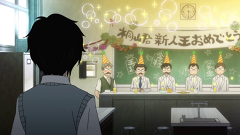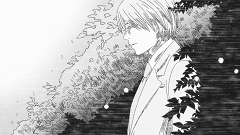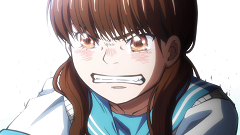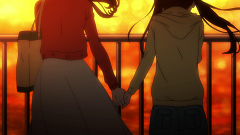It’s been three weeks since my last 3-gatsu post, a gap owed in part to the break the show took around New Years’. Perhaps it’s because of all that time away from the series, or maybe it’s due to the massive difference between these two episodes, but I had a tough time connecting with the characters here. Episode 33 revolved around the quirkier members of the 3-gatsu family, and came out mostly comedic, while its follow-up focused solely on Hina’s bullying drama, and came out mostly not. And while I consider myself a 3-gatsu anime apologist, both of these offerings were disappointing to me. Episode 34, in particular, is my least favorite adaptation of Hinata material yet, featuring a multitude of distracting shot choices and some phoned-in character animation. Shaft’s unmistakable, borderline-invasive style is often the first criticism that people lob at this show, and though I usually view that as a matter of taste, I have to join their ranks this time.
That’s probably enough negativity, yeah? On to “Where the Sun Shines/Small World,” which featured appearances from plenty of fun side characters, both shogi players and members of the Shogi Science Club. Though the most significant developments in this episode were the reveals of two upcoming matches, my favorite moment was a clash between Gakuto and Shimada. Their contrasting personalities were showcased not just visually, but sonically, as well. Listen to the full band that plays behind Gakuto’s mountaineering-based “special attacks,” and then the quiet woodwind performances that underlie Shimada’s calm, calculated moves. That switching of styles makes their face-off a lot funnier, but the show quickly moves to a more reflective mood after Shimada’s victory. He’s dehydrated and exhausted after the win, but also shivering with excitement at having secured the right to fight Yanagihara in the Kishou Championship title match. This mix of the comical and the emotional is where I like 3-gatsu best.
The impending Shimada/Yanagihara battle is only second in importance to Rei’s upcoming match, however. The Chairman has arranged for his young star to go up against Meijin Souya in a commemorative match, all for the sake of maintaining their sponsors’ interest in shogi. Though the event’s planning may be a result of financial concerns, just hearing the news stuns Rei to his core. He looks up to Souya as though he were a god, and because of the parallels that 3-gatsu has drawn between them in the past, we know that this will be the most important match of the series thus far. Later, Rei becomes even more flustered at the outpouring of support that he receives from his school club after earning the Newcomer King title. All of this is enough to drive him to tears midway through the episode, but even that emotional scene failed to get a similar reaction from me. Attached to this show as I am, it’s hard to put my finger on why that is, so I’m not going to spend a lot of words trying. I will note that Rei’s realization (that happy memories can always be called upon, even if your circumstances are unhappy) is a powerful one, though.
“Black Mist/Light” is much bleaker than what came before, what with the breakdown of Hinata’s teacher and the stress placed on Akari as her makeshift parent. The two characters who shine most brightly here are Hina herself (whose determination to “win” against her tormentors is almost feral), and her new instructor Kokubu-sensei, whose zero-tolerance approach to bullying marks a turning point in this story. Kokubu’s sudden need to juggle two separate classes leaves him totally overworked, but I’m guessing he was assigned to Hinata’s class because of his ability to handle these sorts of situations. Unlike his predecessor, he doesn’t let Takagi (or her mother) run him over, which is great news, but the anime’s treatment of his character is too worshipful compared to the manga. Still, this episode had its bright spots, most notably the love shared between the older Kawamoto sisters. Akari is still plagued by worries about her suitedness as a caretaker, which have even started to invade her dreams. The image of her mother on a hospital bed, crying and apologizing for leaving her oldest daughter with such a heavy burden, is hard to watch. But Hinata, full of appreciation for her sister’s appearance at her parent-teacher conference, manages to be strong for the both of them. As Rei pointed out weeks earlier, it’s thanks to Akari that Hina has that strength of character – I just hope she takes those words to heart before too long.





I am quite surprised that you actually don’t really like the execution of this episode. I thought it’s at the very least on par with what SHAFT produced so far, if not better — which is also the general opinion from forum and other blogs I read so far.
Would be interesting if you could elaborate further on “multitude of distracting shot choices and some phoned-in character animation” just for the sake of broadening angle of criticism.
I assume you’re talking about episode 34 in particular. This is what jumped out at me after skimming through it again:
Distracting shot choices:
– The early “black mist scenes” with formless backgrounds. The ones with characters in the shot are fine, but I don’t get any sort of creeping or anxious sensation when the mist isn’t properly framed as encroaching on a particular space.
– Hina’s bow-legged run when retrieving the scroll for the teacher. I assume this was meant to indicate earnestness or innocence, but in either case, a simple jog would have done better.
– Going back to the Monster Grandpa gag for the third time. I was tired of it halfway through the first.
– Takagi’s mother blowing up at Akari. She flies off the handle without warning, but after a series of quick, violent cuts, the next shot we get of her has totally neutral body language.
Character animation:
– The teacher’s breakdown. There were a few good bits, particularly when the show focused on her hands shaking. A lot of the Shaft-y effects were fine. But the full body shots failed to convey mental instability, at least to me.
– Kokubu-sensei running back to mediate between the two families. This was just a panning shot with flailing arms and legs. Not exactly a cardinal sin where anime is concerned, but for this scene in particular, with the urgency of the situation and stampede FX in the background, it was jarring.
– The wide shot of Takagi’s mother arguing with Kokubu-sensei in the second-to-last scene.
Thanks for taking your time to write a detailed response, I just realized that you have wrote a response to my comment. *sadly there’s no email notification on comment section like this
After checking exact scenes that you mentioned, I think I could see where you are coming from (especially the contextless mist, I guess SHAFT still like to use those kind of scene cuts lol). That said, I feel that it’s mostly still what usually what SHAFT did for this series which resulted in a lot of small successful and failure experiments in scene compositions.
Maybe because the tone of this episode is much more serious, it made a jarring one became more obvious.
It may be that all of those visual decisions are par for the course for 3-gatsu; I’d have to go back and watch the entire series (while taking meticulous notes) to find out for sure. They were just particularly distracting for me that week, for whatever reason.
Episode 35 is supposed to involve Chiho-chan in some way, which means I’m automatically going to love it, so the next review ought to be a bit sunnier.
Your article is great but font is too short to read.